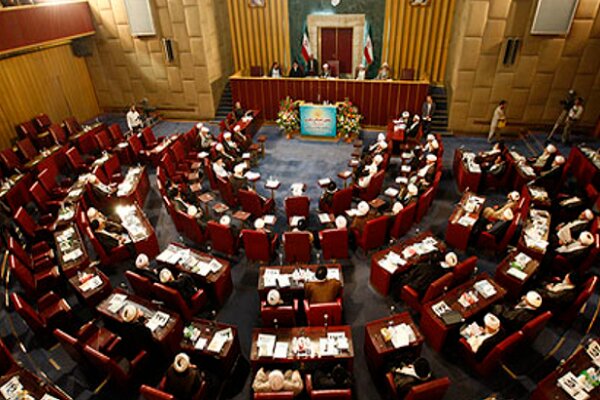The Assembly of Experts is one of the bodies of the Islamic Republic of Iran, whose main task is to elect the Leader and monitor his performance. Each term of this Assembly is 8 years and its members are elected by the people.
The fifth round of the elections of the Assembly of Experts was held on February 26, 2016, and the sixth round will be held on March 1st at the same time as the twelfth parliamentary elections.
The number of the Assembly's representatives is 88. 16 representatives for Tehran province, 6 for Khuzestan and Razavi Khorasan provinces each, 5 for the provinces of Isfahan, East Azarbaijan, and Fars, 4 for each provinces of Gilan and Mazandaran, 3 for West Azarbaijan and Kerman provinces each, 2 for each of the provinces of Ardabil, Alborz, Sistan and Baluchestan, Qazvin, Kordestan, Kermanshah, Lorestan, Golestan, Markazi, and Hamadan, and 1 for each of the provinces of Ilam, Bushehr, Chaharmahal and Bakhtiari, South Khorasan, North Khorasan, Zanjan, Semnan, Qom, Kohgiluyeh and Boyer-Ahmad, Hormozgan and Yazd.
Any increase in the number of representatives will be decided upon in the last year of each period after conducting necessary investigations and according to the population, geographical divisions, and the country's national interests.
How representatives are selected
The Assembly of Experts representatives are elected by direct vote of the people. These elections are held in every province and each person is a representative of a province.
The representatives must be educated in religion and at least be a mujtahid. They should have political and social insight and be familiar with today's issues. They must believe in the Islamic Establishment of Iran and also must not have unfavorable political and social records.
A look at different terms of Assembly
First Assembly:
The Assembly of Experts was established for the first time in 1983. After the demise of Imam Khomeini (RA), who was the founder of the Islamic Revolution and its first Leader, the Assembly selected Ayatollah Seyyed Ali Khamenei as the Leader of the Islamic Revolution on 4 June 1989. This selection was temporary. After the change of the constitution and holding the related referendum, they chose Ayatollah Khamenei as the permanent Leader in a meeting on August 6 of the same year.
Second Assembly:
The election for the second Assembly of Experts was held on 1990 October 8. Its first session was held on 1991 February 21. Ayatollah Ali Meshkini was elected as the chairman of the Assembly of Experts.
Third Assembly:
The election for the third Assembly of Experts was held in 1998. Its first session was held on 1999 February 23. Ayatollah Ali Meshkini was the chairman of the third Assembly of Experts as well.
Fourth Assembly:
The election for the fourth Assembly of Experts was held in 2006. Due to the approval of the coordination of elections in the Islamic Republic of Iran, this term lasted 10 years. Its first chairman was Ayatollah Meshkini and after his demise, Akbar Hashemi Rafsanjani replaced him. Ayatollah Mohammad Reza Mahdavi Kani and Ayatollah Mohammad Yazdi were the next two chairmen of this term.
Fifth Assembly:
The election for the fifth Assembly of Experts was held on 2016 February 26. Its first session was held on 2016 May 24. During the session, Ahmad Jannati was elected as the Assembly's chairman with 51 votes.
During this term, 21 representatives passed away. Among these 21 people, 13 people replaced them in mid-term elections, but 8 of them have not been replaced.
Sixth Assembly:
The election for the 6th Assembly of Experts is scheduled to be held on March 1st. 510 people candidated for this term of the elections of which the qualifications of 144 people were confirmed.
Among the 88 current representatives, 65 have become candidates for this round of election as well.
MNA






Leave a Reply